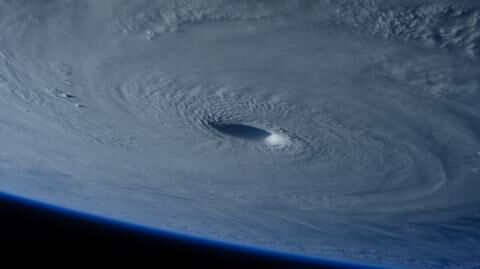Typical hurricanes are easy to spot on satellite images: swirling clouds surround a quieter 'eye.' These storms typically form in the lowest layer of the atmosphere, closer to the Earth's surface, and they trigger heavy rains and high winds.
Discover our latest podcast
Space hurricanes are totally different beasts altogether.
A study published last month in the journal Nature Communications describes the first space hurricane ever observed. In August 2014, satellites observed a swirling mass with a calm center more than 200 kilometers above the North Pole. While ordinary hurricanes stir air, this space hurricane was a vortex of plasma, a type of extremely hot charged gas found throughout the solar system around strong magnetic fields. And instead of rain, this storm brought electron showers.
Michael Lockwood, an astronomer at the University of Reading (England). and co-author of the new study, said in a press release:
Until now, it was not clear whether space plasma hurricanes existed, so to prove it with such a striking observation was incredible.
The space hurricane was nearly 1,000 kilometres wide and was high in the sky - it formed in the ionosphere, between 80 and 965 kilometres above sea level. Michael Lockwood and his co-authors used satellite data to create a 3D model of the storm.
Space hurricanes could wreak havoc on human satellites
The space hurricane lasted eight hours, swirling counter-clockwise. According to the researchers, it had several spiral arms sticking out of its center, much like a spiral galaxy. By connecting satellite data to a computer model, Michael Lockwood and his colleagues were able to reproduce the storm and determine its cause. They found that charged particles emitted from the sun's upper atmosphere, the corona, were responsible for the storm.
This constant flow of solar particles and coronal plasma is known as the solar wind. It travels at about 1.5 million kilometres per hour.
These space hurricanes must be created by the exceptionally large and rapid transfer of energy from the solar wind and charged particles into the Earth's upper atmosphere.
When the solar wind reaches the Earth, it meets the magnetic field of the planet. The Earth has such a field due to the swirling of liquid iron and nickel in its outer core, and it generates electric currents. The magnetosphere shields the planet from deadly radiation from the sun, but also retains a tiny layer of plasma from this solar wind.
In general, solar winds bounce off this protective sheath. But sometimes the charged particles and the incoming plasma interact with the trapped plasma or the electric currents that generate the field. Such interactions create disturbances in the magnetosphere.
The 2014 space hurricane was the result of one of these disturbances.
The study's authors suggested that an interaction between the Earth's magnetic field and parts of the solar magnetic field - carried by the solar wind - contributed to the formation of the hurricane.
Usually, magnetic fields do not mix. But if they get closer, parts of the fields can realign and even merge, forming a new pattern of magnetic energy. This is probably what happened on the day of the space storm: an influx of solar wind energy formed a new configuration above the Earth's magnetic north pole.
The storm acted as a channel from space to Earth's atmosphere, channelling some electrons beyond the planet's protective cover.
This shower of particles could have wreaked havoc on our high-frequency radio communications, our radar detection systems or our satellite technology, according to the study's authors. This is because charged solar particles that infiltrate the Earth's magnetic field can cause malfunctions in the computers and circuits of satellites and the International Space Station. Fortunately, in this case, no problem was observed.
Other planets can also experience space hurricanes
Earth isn't the only planet to have experienced hurricanes - similar weather conditions occur on Mars, Saturn, and Jupiter. But this is the first time that scientists have spotted a hurricane in the upper atmosphere of a planet in the solar system.
According to Michael Lockwood, any planet or moon with a magnetosphere could experience a space hurricane. All the planets in our solar system, except Venus and Mars, have a magnetosphere.
Plasma and magnetic fields in the atmosphere of planets exist throughout the universe, so the results suggest that space hurricanes should be a widespread phenomenon.















